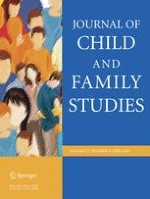27-11-2017 | Original Paper
Validity of Adolescent and Parent Reports on the Six-Item ADHD Self-Report Scale (ASRS-6) in Clinical Assessments of Adolescent Social Anxiety
Gepubliceerd in: Journal of Child and Family Studies | Uitgave 4/2018
Log in om toegang te krijgenAbstract
Adolescents experiencing social anxiety often experience co-occurring attention-deficit/hyperactivity disorder (ADHD) symptoms. Yet, assessing for social anxiety poses challenges given the already time-consuming task of distinguishing social anxiety from other commonly co-occurring internalizing conditions (e.g., generalized anxiety, major depression). Assessors need short screening devices to identify socially anxious adolescents in need of intensive ADHD assessments. A six-item version of the ADHD Self-Report Scale (ASRS-6) was originally developed to identify adults who likely meet diagnostic criteria for ADHD, but its psychometric properties have yet to be examined among adolescents. We tested the psychometric properties of the ASRS-6 when administered in clinical assessments for adolescent social anxiety. Eighty-nine 14–15 year old adolescents and their parents (67.4% female; 62.1% African American; 30 Clinic-Referred; 59 Community Control) completed the ASRS-6, measures of adolescent social anxiety and depressive symptoms, and parent-adolescent conflict. Adolescent self-reported and parent-reported ASRS-6 positively related with scores from established measures of social anxiety, depressive symptoms, and parent-adolescent conflict. Further, adolescent self-reported (but not parent-reported) ASRS-6 scores significantly discriminated adolescents on referral status. Adolescent self-reported (but not parent-reported) ASRS-6 scores incrementally predicted social anxiety over-and-above depressive symptoms, which commonly co-occur with social anxiety. Conversely, parent-reported (but not adolescent self-reported) ASRS-6 scores incrementally predicted parent-adolescent conflict over-and-above depressive symptoms, which commonly co-occur with conflict. When assessing adolescent ADHD symptoms, adolescents’ and parents’ reports meaningfully vary in their links to validity indicators. As such, among adolescents assessed for social anxiety, clinical assessments of adolescent ADHD symptoms should include both parent reports and adolescent self-reports.
